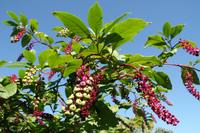Peduncle (botany)



In botany, a peduncle is a stalk supporting an inflorescence or a solitary flower, or, after fecundation, an infructescence or a solitary fruit. The peduncle sometimes has bracts (a type of cataphylls) at nodes. The main axis of an inflorescence above the peduncle is the rachis. There are no flowers on the peduncle but there are flowers on the rachis.[1][2][3]
When a peduncle arises from the ground level, either from a compressed aerial stem or from a subterranean stem (rhizome, tuber, bulb, corm), with few or no bracts except the part near the rachis or receptacle, it is referred to as a scape.[2]
The acorns of the pedunculate oak are borne on a long peduncle, hence the name of the tree.
See also
[edit]References
[edit]- ^ Harris, James G.; Harris, Melinda Woolf (2001). Plant Identification Terminology: An Illustrated Glossary (2nd ed.). Spring Lake, Utah: Spring Lake Publishing. ISBN 978-0-9640221-6-4. OCLC 45951032.
- ^ a b Henslow, John Stevens (2009). A Dictionary of Botanical Terms. Cambridge: Cambridge University Press. ISBN 978-0-511-70154-2. OCLC 889956193.
- ^ Beentje, Henk (2010). The Kew Plant glossary: An Illustrated Dictionary of Plant Terms. Richmond, Surrey, UK: Royal Botanic Gardens, Kew. ISBN 978-1-84246-422-9. OCLC 464589004.


 French
French Deutsch
Deutsch